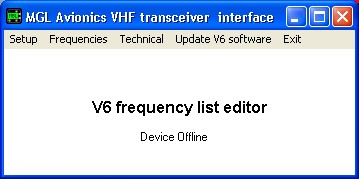






Uploading new firmware to the V6 requires use of a RS232 serial interface on your PC (USB to RS232 adaptors tend to work OK). Alternatively you can update your V6 via any iEFIS system or the Odyssey/Voyager G2 (ensure that you have the current EFIS firmware before you do this, older versions to not support this).
For the RS232 connection cable needs to be constructed that connects the RX and TX as well as ground lines from the PC to the D15 connector on the back of the V10. The V6 has two serial ports and for the update serial port 1 needs to be used (RX1 and TX1). The V6 needs to be suppied from a 12V power source during the firmware update.
PC D9 --- V6 D25
2 --- 16 (RX PC connects to V6 TX1)
3 --- 3 (TX PC connects to V6 RX1)
5 --- 14 (GROUND PC to GROUND V6)
NEG --- 14 (negative from power supply connects to ground of RS232 from PC as well)
+12V --- 1 (12V supply to radio during firmware update, regulated power supply or 12V battery)
Current draw less than 200mA typical during firmware update. Do not TX without antenna or dummy load connected !
Please contact your supplier if you are unable to perform the update yourself.

The current firmware version is 120816 (DDMMYY).
Changes:
New digital audio filtering of the microphone signals with very steep responses based on cockpit spectral noise research results.
Faster reaction time for all Vogad noise reduction algorithms.
Longer delay to switch off for VOX intercom (extended to one second)
New band filter implementation for very noisy environments with two settings (Mild and Strong).
Dual volume settings: Radio RX and Intercom now have independent volumes. Rotate volume knob to set radio volume. Press volume knob briefly and then rotate to set Intercom volume.
RF feedback elimination system. Digital signal processing eliminates effects of RF feedback in compromised installations.
Doubled rate of radio status transmission on RS232 for remote control systems.
Modifications to PTT join/separate operation allows voice on intercom from blocked source but not on air.
Download the Firmware file for updating the radio via an MGL EFIS here:
V6Firmware.bin
Instructions are below
V6 update instructions via MGL EFIS.
You have your V6 connected to an MGL EFIS using the V6 serial port number 1 (port number 2 cannot be used for updating), you have any model of iEFIS or an Odyssey/Voyager G2 and you have updated your EFIS to run the current firmware.
You can switch off power to the V6 radio while running the EFIS (you can use a breaker or pull a fuse as well).
Download file V6Firmware.bin. Copy to an SD card (root folder). Insert into EFIS. Go to System Setup Menu -> Upload Firmware to MGL device. Select file V6Firmware.bin from selection shown. A small selection pops up showing you MGL radio devices configured on the system (note the port numbers). Select the radio you want to update. System asks to remove power from the radio. Do that and confirm. System now asks to apply power to the radio. If all goes well and radio powers up the system now shows you the currently installed firmware information and asks you to proceed. Note that your radios display does not show anything. That is expected.
Proceed and observe the progress. It takes a minute or two. When the programming reaches 100% a message will show that the device programmed OK for a few seconds. Now remove power from the radio and re-apply power after two seconds or more. The radio should now start up with the new firmware. Note: On some displays it may start up with the display contrast being very faint - shade the display so you can read it, go to the menu and set the contrast so you have a good display image.
Should the programming for some reason be interrupted or fail, the radio will no longer start up afterwards. However you can repeat the above procedure as many times as you like - the programming mechanism in the radio does not depend on a working set of firmware installed.







